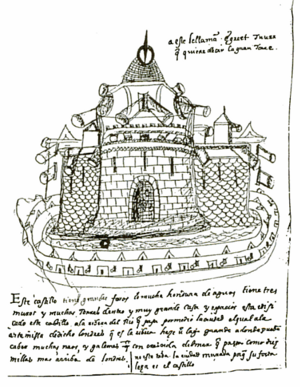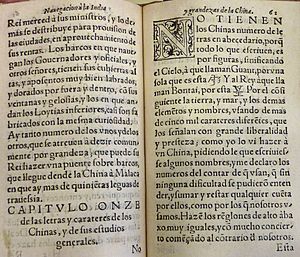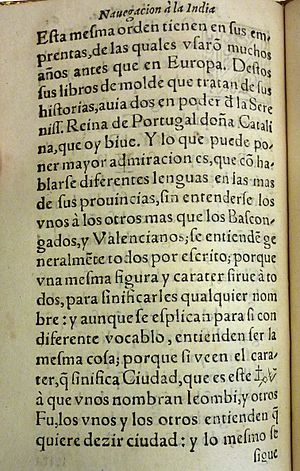Bernardino de Escalante facts for kids
Bernardino de Escalante (born around 1537, died after 1605) was a Spanish soldier, priest, geographer, and a writer. He is most famous for writing the second book about China published in Europe. His book was also the first one about China to be widely read outside of Portugal.
For a long time, not much was known about his life. But in recent years, researchers like Rufo de Francisco have found out a lot more about him.
Contents
About Bernardino de Escalante

Bernardino de Escalante was born in Laredo, Cantabria, a region in Spain. His family were hidalgos, a type of Spanish nobility. His father, García de Escalante, was a sea captain and shipowner. Laredo was a very important port back then. Bernardino often sailed with his father to Flanders (part of modern-day Belgium) twice a year. This helped him learn about the sea.
His mother, Francisca de Hoyo, also came from an important family. Her sister was married to Pedro del Hoyo, who was a secretary to Prince Philip.
In 1554, young Bernardino joined Prince Philip's group. He sailed on his father's ship, La Concepción, which was part of the fleet taking Prince Philip to England. Philip was going to marry Mary I of England. Bernardino stayed in England for 14 months, learning a lot about the country. This knowledge showed up in his later writings.
From 1555 to 1558, Bernardino fought in a war in Flanders, including the Battle of St. Quentin. After the wars ended, he wanted a more peaceful life. He decided to study and become a scholar or a priest. We don't know which university he attended.
In the 1570s, he worked for a church in Laredo. He also served as a special representative for the Spanish Inquisition in Galicia. This job often took him to Lisbon and Sevilla. Later, he moved to Sevilla, which was Spain's main port for trade with America. In 1581, he was an inquisitor there and also worked for the Archbishop of Seville.
Spanish records show that Escalante wrote many important papers for King Philip II and his officials between 1585 and 1605. These papers discussed important world issues, especially the difficult relationship between Spain and England. Historians believe King Philip II carefully read these documents.
Bernardino de Escalante's first published book was called Discurso de la navegacion que los Portugueses hacen a los Reinos y Provincias de Oriente, y de la noticia que se tiene de las grandezas del Reino de la China. This long title means Discourse of the navigation made by the Portuguese to the kingdoms and provinces of the Orient, and of the existing knowledge of the greatness of the Kingdom of China.
The book was published in Sevilla in 1577. It was the second European book mainly about China. The first was Tratado das cousas da China (1569) by Gaspar da Cruz.
What the Book Was About
Escalante's Discurso was a small book, about 200 pages long. It had two main parts. The first part (chapters 1-5) talked about how the Portuguese explored the sea routes to Southeast Asia. The second part (chapters 6-16) tried to describe China. It covered China's geography, economy, and culture, based on what Europeans knew at that time. The last page listed the author's sources.
Bernardino de Escalante himself never traveled to China. He explained that his book was a summary of information from other sources. He used books written by Portuguese authors, like Gaspar da Cruz, who had visited China. He also used writings by João de Barros, who had access to Chinese books and a Chinese person who could read them for him. Escalante also interviewed Portuguese merchants who had sailed to China. He even spoke with some "people of China" who had come to Spain.
How the Book Became Famous
Unlike Gaspar da Cruz's book, which was not very well known outside Portugal, Escalante's book quickly became popular. It was translated into other European languages. An English translation by John Frampton came out in 1579.
Escalante's Discurso was an important source for an even bigger book. This was Juan González de Mendoza's Historia de las cosas más notables, ritos y costumbres del gran reyno de la China (1585). Mendoza's book became the main source of information about China in Europe for many years.
Chinese Language in the Book
Chapter XI of the Discurso talks about the Chinese writing system and education. Escalante described Chinese writing as having no alphabet. Instead, it used thousands of different characters. Each character represented a meaning, not just a sound. This system helped people from different parts of China, or even from Japan and Vietnam, communicate through writing, even if they spoke different languages.
Escalante's book showed three examples of Chinese characters. They were a bit distorted, but they were among the earliest Chinese characters printed in a European book. These examples became very important. They were copied into other famous books, like Abraham Ortelius's atlas Theatrum Orbis Terrarum (1584 edition) and Mendoza's Historia ... de la China (1585).
People have discussed what the original Chinese characters Escalante showed might have been.
- The first character, said to mean "heaven," might have been 穹 (qióng).
- The second character, said to mean "king," was likely a distorted 皇 (huáng), which is part of the word for "emperor."
- The third character, said to mean "city," was probably a poorly drawn 城 (chéng).
Remembering Bernardino de Escalante
A high school in Laredo, Spain, is named after Bernardino de Escalante. It is called "IES Bernardino de Escalante."
See also
 In Spanish: Bernardino de Escalante para niños
In Spanish: Bernardino de Escalante para niños
- Escalante, Cantabria - a town near Bernardino de Escalante's hometown.




